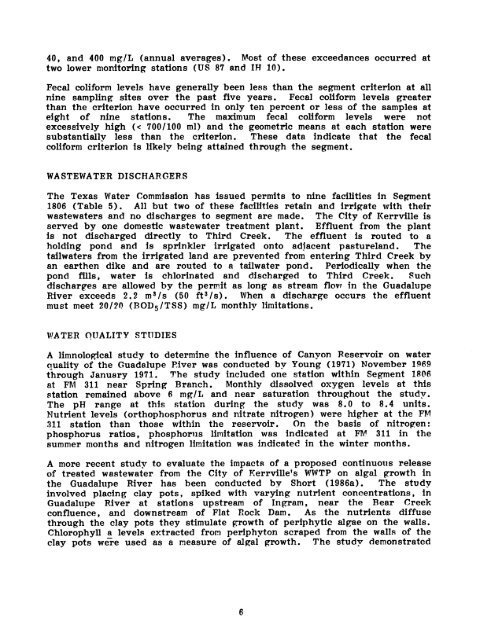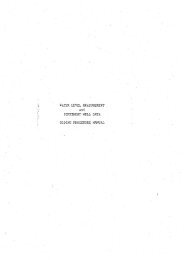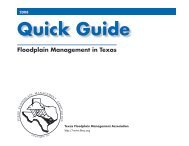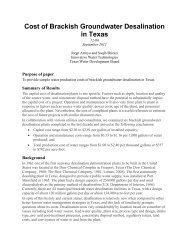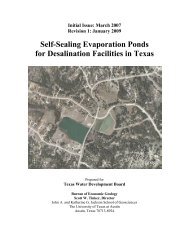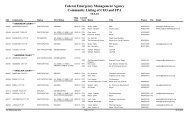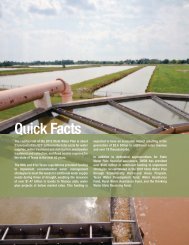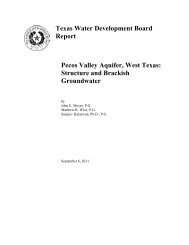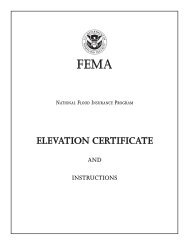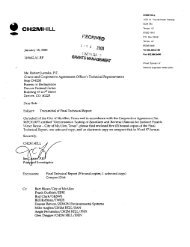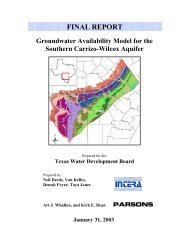Intensive Survey of the Guadalupe River Segment 1806
Intensive Survey of the Guadalupe River Segment 1806
Intensive Survey of the Guadalupe River Segment 1806
You also want an ePaper? Increase the reach of your titles
YUMPU automatically turns print PDFs into web optimized ePapers that Google loves.
40, and 400 mg/L (annual averages). Most <strong>of</strong> <strong>the</strong>se exceedances occurred at<br />
two lower monitoring stations (US 87 and IH 10).<br />
Fecal coliform levels have generally been less than <strong>the</strong> segment criterion at all<br />
nine sampling sites over <strong>the</strong> past five years. Fecal coliform levels greater<br />
than <strong>the</strong> criterion have occurred in only ten percent or less <strong>of</strong> <strong>the</strong> samples at<br />
eight <strong>of</strong> nine stations. The maximum fecal coliform levels were not<br />
excessively high (< 700/100 ml) and <strong>the</strong> geometric means at each station were<br />
substantially less than <strong>the</strong> criterion. These data indicate that <strong>the</strong> fecal<br />
coliform criterion is likely being attained through <strong>the</strong> segment.<br />
WASTEWATER DISCHARGERS<br />
The Texas Water Commission has issued permits to nine facilities in <strong>Segment</strong><br />
<strong>1806</strong> (Table 5). All but two <strong>of</strong> <strong>the</strong>se facilities retain and irrigate with <strong>the</strong>ir<br />
wastewaters and no discharges to segment are made. The City <strong>of</strong> Kerrville is<br />
served by one domestic wastewater treatment plant. Effluent from <strong>the</strong> plant<br />
is not discharged directly to Third Creek. The effluent is routed to a<br />
holding pond and is sprinkler irrigated onto adjacent pastureland. The<br />
tailwaters from <strong>the</strong> irrigated land are prevented from entering Third Creek by<br />
an ear<strong>the</strong>n dike and are routed to a tailwater pond. Periodically when <strong>the</strong><br />
pond fills, water is chlorinated and discharged to Third Creek. Such<br />
discharges are allowed by <strong>the</strong> permit as long as stream flovr in <strong>the</strong> <strong>Guadalupe</strong><br />
<strong>River</strong> exceeds 2.2 m3/s (50 ft3/s). When a discharge occurs <strong>the</strong> effluent<br />
must meet 20/20 (BOD5/TSS) mg/L monthly limitations.<br />
WATER QUALITY STUDIES<br />
A limnological study to determine <strong>the</strong> influence <strong>of</strong> Canyon Reservoir on water<br />
quality <strong>of</strong> <strong>the</strong> <strong>Guadalupe</strong> <strong>River</strong> was conducted by Young (1971) November 1969<br />
through January 1971. The study included one station within <strong>Segment</strong> <strong>1806</strong><br />
at FM 311 near Spring Branch. Monthly dissolved oxygen levels at this<br />
station remained above 6 mg/L and near saturation throughout <strong>the</strong> study.<br />
The pH range at this station during <strong>the</strong> study was 8.0 to 8.4 units.<br />
Nutrient levels (orthophosphorus and nitrate nitrogen) were higher at <strong>the</strong> FM<br />
311 station than those within <strong>the</strong> reservoir. On <strong>the</strong> basis <strong>of</strong> nitrogen:<br />
phosphorus ratios, phosphorus limitation was indicated at FM 311 in <strong>the</strong><br />
summer months and nitrogen limitation was indicated in <strong>the</strong> winter months.<br />
A more recent study to evaluate <strong>the</strong> impacts <strong>of</strong> a proposed continuous release<br />
<strong>of</strong> treated wastewater from <strong>the</strong> City <strong>of</strong> Kerrville's WWTP on algal growth in<br />
<strong>the</strong> <strong>Guadalupe</strong> <strong>River</strong> has been conducted by Short (1986a). The study<br />
involved placing clay pots, spiked with varying nutrient concentrations, in<br />
<strong>Guadalupe</strong> <strong>River</strong> at stations upstream <strong>of</strong> Ingram, near <strong>the</strong> Bear Creek<br />
confluence, and downstream <strong>of</strong> Flat Rock Dam. As <strong>the</strong> nutrients diffuse<br />
through <strong>the</strong> clay pots <strong>the</strong>y stimulate growth <strong>of</strong> periphytic algae on <strong>the</strong> walls.<br />
Chlorophyll a levels extracted from periphyton scraped from <strong>the</strong> walls <strong>of</strong> <strong>the</strong><br />
clay pots were used as a measure <strong>of</strong> algal growth. The study demonstrated


